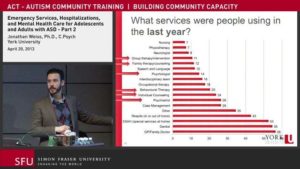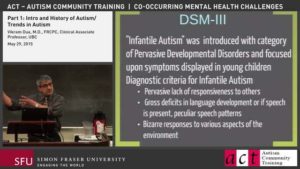Filmed May 2015 – edited into 14 parts; total 187 minutes
Children with ASD have very high rates of co-occurring mental health challenges, carrying a 75% risk that they will be identified with conditions including ADHD, anxiety disorders and tic disorders prior to reaching adulthood. Frequently it is these conditions and not autism itself that is the most disabling factor in the life of a child with ASD. Treatment typically leads to a substantial improvement in functioning – independent of the degree of disability. Dr. Dua, a leading child psychiatrist, introduces his approach, the Autism Comorbidity Algorithm (ACA), which frames and guides clinical and diagnostic assessment and treatment decisions through a developmental lens. The goal of the ACA is to use a life-span orientation to assess both the benefits and risks of treatment. It is based on a careful identification of the co-occuring disorders, aiming for holistic improvement in the child’s functioning with the goal of preventing future complications. Dr. Dua focuses particular attention on the overuse of potent anti-psychotic medications in the treatment of ASD and the underuse of medications with a stronger evidence base.
About the Presenter
Dr. Dua is Psychiatrist-in-Chief at Surrey Place Centre, and Assistant Professor, Department of Psychiatry, University of Toronto. He is trained as a Child and Adolescent, and Forensic psychiatrist. His clinical and research interests are with complex children, youth and young adults with autism and developmental disabilities – “dual diagnosis”, and systems of care that partner with community providers to improved community access to evidence-based treatments, and efficient use of expert resources. Dr. Dua earned a B.Sc. from the University of Toronto, then completed Medical School at McMaster University, Residency at Harvard Medical School, and fellowships at the University of Massachusetts. He also holds appointments in the Departments of Psychiatry and Pediatrics at U.B.C. Dr. Dua has nearly 20 years’ experience developing and implementing new dual diagnosis services in British Columbia. He authored the “Standards and Guidelines” – a government policy paper establishing eligibility requirements for all public ASD services in B.C. He was the co-founder and first medical director of the BC Autism Assessment Network, a highly-regarded province-wide interdisciplinary disciplinary program. Dr. Dua also co-led the award-winning PARC ASD Training Program. More recently, Dr. Dua has introduced the Shared-Care Pathway in B.C. which spans developmental and mental health frameworks to better address psychiatric needs of those with dual diagnosis.
Part 1: Intro and History of Autism/ Trends in Autism (17:26)
Part 2: Autism in the DSM-5 (8:27)
Part 3: Comorbidity in ASD and Intellectual Disability (8:04)
Studies referenced:
- Goldstein & Schwebach 2004
- Gadow et al. 2006
- Leyfer et al 2006
- Lee & Ousley, 2006
- Grzadzinksi et al. 2011
Part 4: Barriers to Diagnosis and Relevance of Comorbidity (7:53)
Study referenced: Leyfer et al 2006
Part 5: ASD Comorbidity Algorithm – Step 1: Development and Intervention (15:21)
- In this chapter: Case Study: BJ, part 1 – a 10 year old boy with previously diagnosed developmental delays
Part 6: BCAAN Assessment/ ASD and Developmental Disorders (12:32)
- In this section: Case Study: BJ Case Study, parts 2 and 3
Part 7: ASD Comorbidity Algorithm – Step 2: Evaluation (8:20)
- In this section: Case Study: CJ, Part 1 – a 13 year old boy with social and learning challenges. School and pediatrician wonder if it’s ASD?
Part 8: ASD and Anxiety Disorders (12:01)
- In this chapter: Case Study: CJ, Part 2
Part 9: ASD and the Neuro-Psychiatric Triad & Dual Diagnosis (14:07)
- In this chapter: Case Study: CJ, Part 3
Part 10: ASD Comorbidity Algorithm – Step 3: Treatment (20:33)
- In this chapter: Case Study: Boy, 11 year old referred by his pediatrician for consideration of medication for behaviours.
Part 11: Treatment and Medication (15:54)
Part 12: ASD Co-Morbidity Algorithm: Assumptions and Rules (18:02)
- In this section: Case Study, DJ, 13 year old boy with ASD
Part 13: Treatment Initiation – Early Data on Stimulants in ASD (22:50)
Part 14: Treatment Follow Through (5:48)
- In this section: Case Study, DJ, continued






